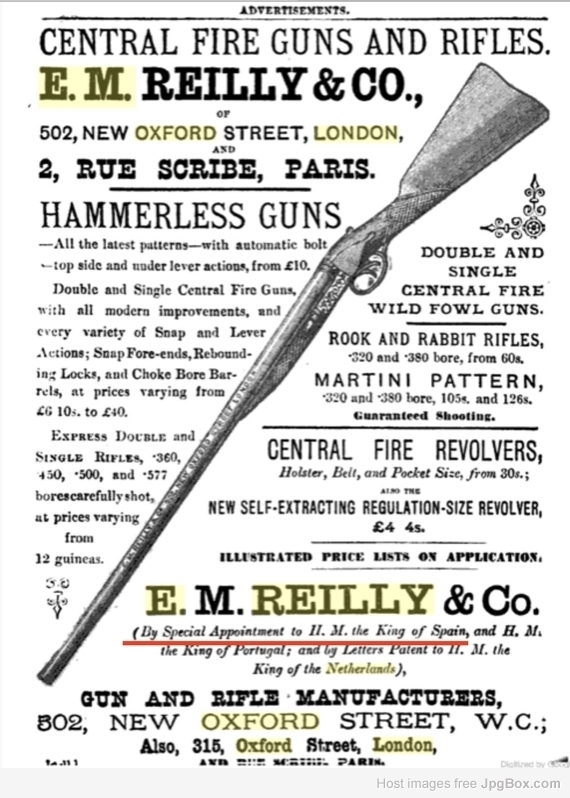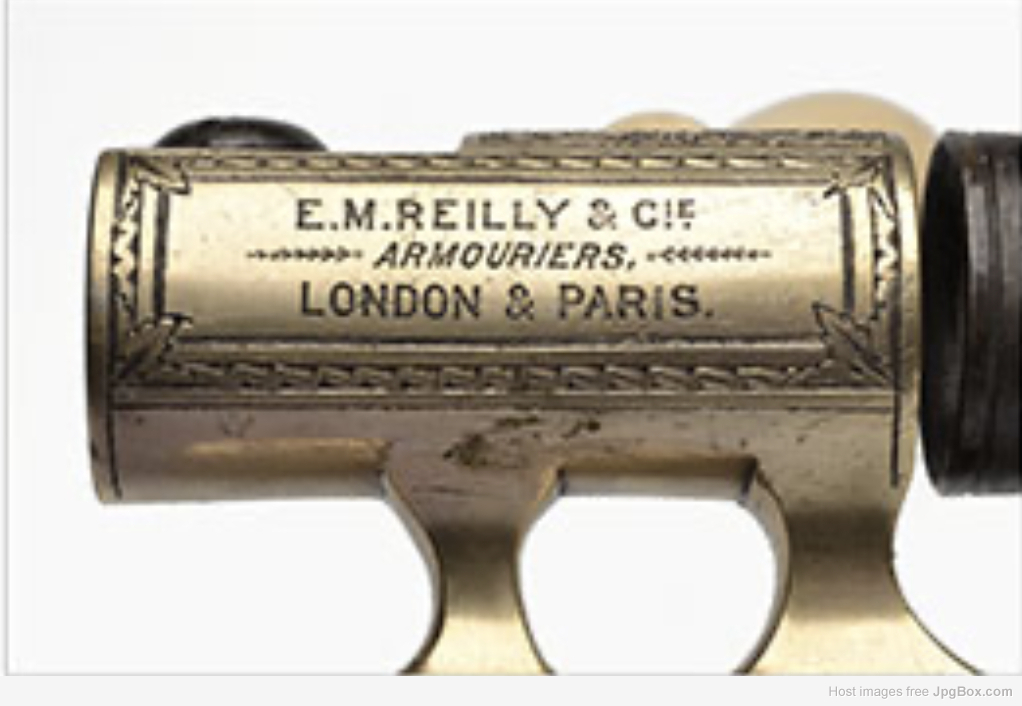|
S |
M |
T |
W |
T |
F |
S |
|
|
1
|
2
|
3
|
4
|
5
|
6
|
|
7
|
8
|
9
|
10
|
11
|
12
|
13
|
|
14
|
15
|
16
|
17
|
18
|
19
|
20
|
|
21
|
22
|
23
|
24
|
25
|
26
|
27
|
|
28
|
29
|
30
|
|
|
|
|
|
|
1 members (1 invisible),
363
guests, and
6
robots. |
|
Key:
Admin,
Global Mod,
Mod
|
|
|
Forums10
Topics38,466
Posts545,091
Members14,409
| |
Most Online1,258
Mar 29th, 2024
|
|
If a specific post was interesting or useful to you, we recommend that you Like that post. It tells the post author, and others, that you found the information valuable. Clicking Like is another way to let others know that you enjoy it without leaving a comment.
Log in to join the conversation and Like this content.
|
|
|
 Re: Nice surprises with cased gun purchases
#588958
Jan 3rd a 12:07 AM Re: Nice surprises with cased gun purchases
#588958
Jan 3rd a 12:07 AM
|
| by Argo44 |
| Argo44 |
I've known of that Royal Reilly for years and have commented previously on it. https://www.doublegunshop.com/forums/ubbthreads.php?ubb=showflat&Number=436538&page=54The Reilly is SN 25161. And there-in lies a conundrum. That gun was numbered in mid 1883. The case has an inscription indicating it was given as a shooting prize by King Alfonso XII in 1880. So how come the gun is made in 1883? Something is strange here - perhaps the order was delayed; or put in after a couple of years of forgetfulness, or maybe the original was stolen and 25161 was commissioned as a replacement. Who knows? Qui m'o sabe (per Tanto). Then again the family that wound up with it were "cattle dealers," who had relationships with a notorious bandit (j0e's type of people, but much more organized, energetic and effective, not just sitting around west-Tennessee-like, scratching butt while toking on meth and swilling shine): Here is the original advertisement. Lots to read between the lines. http://auctions.holtsauctioneers.com/asp...4&saletype=Estimate £15,000-20,000
E.M. REILLY & CO.
A RESPLENDENT CASED PRESENTATION 12-BORE SIDELEVER BAR-IN-WOOD HAMMER RIFLE AND SHOTGUN GARNITURE, serial no. 25161,
25 1/2in. black powder only bold damascus rifled barrels with raised finely file-cut rib, open sights and two folding leaf sights marked for 50, 100 and 200 yards and with fine acanthus scroll detailing and gold-inlaid sight lines, bead fore-sight, the breech end with feathered bands and a single gold line, the tubes gold-inlaid 'E.M. REILLY & CO. NEW OXFORD ST. LONDON. AND 2. RUE SCRIBE. PARIS.', individual fore-end with Anson push rod release catch, the iron retaining much original colour-hardening;
-- 29 3/4in. black powder only fine damascus barrels, raised rib with scroll detailing and gold-inlaid 'E.M. REILLY & CO. 502. NEW OXFORD STREET. LONDON & RUE SCRIBE. PARIS.', the breech ends with feathered bands and single gold line, individual fore-end with Anson push rod release catch, the iron retaining much original colour-hardening;
-- sidelever action with Purdey 1863 patent double bite, carved percussion fences, rebounding bar locks by Stanton, bar-in-wood, standing breech with fine beaded border engraving, the action, lockplates and furniture profusely engraved with fine acanthus scrolls, the top tang finely inset in gold with the crest of Alfonso XII, the lockplates gold-inlaid 'E.M. REILLY & CO. LONDON.',
-- the triggerguard tang gold-inlaid with the serial number, retaining much original colour-hardening,
-- 14 1/4in. well-figured stock with sling eye, blank gold oval escutcheon and including horn buttplate, weight 9lb. 1oz. (rifle barrels) and 7lb. 3oz. (shot barrels),
-- in its fine brass-cornered oak and leather case with blue velvet lining, fully fitted to house a virtually full complement of reloading tools (some ivory-handled) by Hawkesley and Dixon, with Greenfield crimping tool and fine scroll engraved capper/de-capper and roll turnover tool with E.M. Reilly & Cie. (London & Paris) markings, the lid interior embossed in gold leaf with the makers details, the lid exterior mounted with an ornately carved and engraved frame, with central crowned monogram for Alfonso XII and brass banner pierced with 'CONCURSO DE TIRO DE 1880'
Provenance: The crests on both the gun and the case refer to Alfonso Francisco de Asis Fernando Pio Juan Maria de la Concepcion Gregorio Pelayo, King Alfonso XII of Spain. Born November 1857, died November 25th 1885.
Alfonso reigned as Monarch from 1874 until his untimely death from illness in 1885. His coming to power, upon the abdication of his mother, Queen Isabella II marked the end of the first Spanish Republic, established following the 'Glorious Revolution' in 1868 which saw the monarchy forced into exile.
His rule was popular and peaceful and he, together with his Prime Minister were responsible for ending the civil war and drafting a new constitution designed to restore stability and economic growth to Spain.
His interest in shooting was undoubtedly influenced by time spent in England, and having experienced the sport of driven partridge shooting (introduced in England in around 1854) he was responsible for introducing the first partridge drive in Spain just south of Toledo in 1880.
We are kindly informed by the vendor that the gun has been in the possession of the family since it was purchased by his Great Grandfather, Mr Juan Agudo Valero in the 1880's.
His livestock business brought him into social circles of all levels, from contact with Royalty to a long lasting friendship with Manuel Mejis, a top bullfighter popularly called 'The Black Pope' and even extending to a friendship with Juan Camargo Gomez - a notorious bandit, known as 'TheVivillo' (to whom Juan sent emergency funds when forced to flee to Argentina to escape arrest)
The gun was commissioned by King Alphonso XII and gifted as a prize for a 'Throw' shooting competition (Live Pigeon match) by the King in 1880. Family tradition has it that the gun was won by an auspicious military man who was did not hunt or shoot as a pastime; the prize was bought from him by Juan - perhaps as a future gift for a person of influence. However, the gift was never realised and the gun has been passed down through the family ever since. (WTF??? - how can you win a pigeon shoot without hunting or shooting being a pastime??)
It has only been out of their direct possession once until now, being buried in the courtyard of the family home during the Spanish Civil War of 1936-39 (where the light damage to the case externals was accrued). Reilly began advertising a connection to first the Portuguese Royal family (around 1876) and then about 1881 to the Spanish Royal family and the King of the Netherlands. 1881 Bradshaw advertisement: Interesting that Reilly chose to emphasize on the accoutrements his Paris branch (which only sold retail and took orders). Again, Reilly was an Irish Catholic and was snubbed by the UK Royal Family in 1862...It could be this was an effort to reinforce the Catholic connections to France, Spain and Portugal: 
|
|
|
|